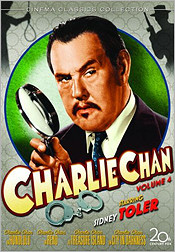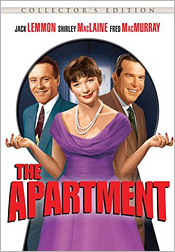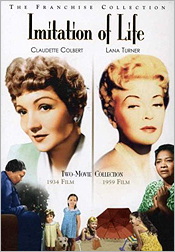 |
Site created 12/15/97.

page created: 2/18/08
 Barrie Maxwell - Main Page |
| Classic
Reviews Round-Up #43, Western Views and News, and New Announcements In this edition of Classic Coming Attractions, I have reviews of the Charlie Chan Collection: Volume 4 from Fox; Junior G-Men of the Air from VCI; The Apartment: Collector's Edition and In the Heat of the Night: 40th Anniversary Edition from MGM; Pioneers of Television from Paramount; and the Imitation of Life: Two-Movie Special Edition from Universal. I've also separated coverage of western titles into its own section, partially reflecting the current releases of three new western films that obviously fall outside our normal classic time period. Reviewed are: The Assassination of Jesse James by the Coward Robert Ford from Warner Bros., and September Dawn and Comanche Moon from Sony. You'll find some western release news in both this section as well as in the normal classic announcements section. Following that, I have the usual section summarizing the latest classic title announcements. Included there also is news of Warner Bros.' plans for 2008, the studio's 85th anniversary year. Classic fans should note that Warners' announcements in this regard represent only some of their plans for the year. We should expect just as aggressive a program of classic releases from the studio as we've come to expect over the past several years. Both the classics and western release databases have been updated accordingly. Reviews Fox's Charlie Chan Collection: Volume 4 is a very welcome arrival. It contains the first four films that starred Sidney Toler as Chan, replacing Warner Oland who had died in 1938. The films are not available individually.  Charlie Chan in Honolulu finds the famous detective on his home turf trying to unravel a murder on board a freighter arriving at Honolulu harbour. Aside from Toler, the film also has Sen Yung playing Number Two Son, replacing the work of Keye Luke as Number One Son. Despite the presence of George Zucco among the suspects, this entry lacks in spark and originality, resorting to too much screen time for a lion (part of a shipment of animals on the vessel) and his inane trainer. Toler, however, captures the essence of Chan effectively, auguring well for the future of the series, and the remaining films in the set, all originally released in 1939, are winners. Charlie Chan in Reno is the first of these, with Chan attempting to solve the murder of an obnoxious mistress at a hotel in the divorce capital. A strong cast (Ricardo Cortez, Slim Summerville, Phyllis Brooks, Kane Richmond) helps to disguise the murderer well. Charlie Chan at Treasure Island is considered to be one of the high points of the Charlie Chan films and I would certainly agree. Set at the location of the 1939 World's Fair in San Francisco, the film is strongly atmospheric and has the look of an A picture. Chan is faced with solving a friend's murder, one tinged with an element of the supernatural intertwined with a mysterious mystic named Dr. Zodiac. Cesar Romero is very good in a featured role, but the likes of Pauline Moore, Douglas Fowley, Douglas Dumbrille and Donald MacBride offer familiar and effective support too. Charlie Chan in City in Darkness is a favorite of mine. Set in Paris at the time of the Munich Agreement, with the city subject to blackouts due to the threat of air raids, Chan tracks down a band of arms dealers supplying munitions to Germany. The film effectively captures the feeling of Paris as well as the ominous pre-World War II times. The beautiful Lynn Bari and reliable Harold Huber are featured. As for the DVD transfers, Fox spent a good deal of money to restore its Chan films and the evidence is firmly on display in these four titles. Correctly presented full frame, all look crisp and clean with good shadow detail and deep blacks. The mono sound is in good shape on all. Even better is the effort that Fox has made on the supplementary features. We get an audio commentary from film critic Ken Hanke and film historian John Cork on one of the titles (Treasure Island) and a nice set of two or three featurettes on all of them (the featurettes focus on such aspects as the real locations mentioned in the titles, various cast or crew members, as well as speculations [did the San Francisco Zodiac killer of the 1960s/1970s get inspiration from Treasure Island's Dr. Zodiac character]). There's even a recreation of the lost Charlie Chan's Courage, based on the shooting script and still photographs. Highly recommended, and bring on Volume 5! Fans of other detective series films held by Warner Bros. and Columbia should be so lucky! Junior G-Men of the Air is a 1942 12-chapter Universal serial starring the Dead End Kids and a follow-up (not a sequel) to the studio's Junior G-Men serial made two years previously.  Most of the same gang of Dead End Kids return including leader Billy Halop, second banana Huntz Hall, and the likes of Bernard Punsley and Gabriel Dell. The 1942 effort, in which The Kids team up with the head of the federal junior G-men (Frank Albertson) in order to capture a gang of enemy agents led by The Baron (Lionel Atwill - his casting is a strong benefit for the serial), is an improvement over its predecessor, sporting a more interesting and coherent story as well as better-staged action sequences. Some of the best of them occur either in the air (Halop's character qualifies as a pilot, a useful ability given the enemy gang's reliance on planes to carry out its schemes), at The Baron's secret farm headquarters, or in an oil field that The Baron's gang tries to sabotage. VCI's presentation is on a single disc and looks quite good. It's a definite improvement over the Alpha release (the only other DVD version of the title that I have) which is much softer and lacking in image detail. There are still lots of scratches and debris, but the viewing experience is more than just acceptable. Supplements include a cartoon (Daffy the Commando - decent colour, plenty of scratches), the serial's trailer, and a short photo gallery. Recommended for serial fans. I don't think I need say much about the appeal of The Apartment, Billy Wilder's 1960 Academy Award winning Best Picture.  The film is a superbly-written (by Wilder and collaborator I.A.L. Diamond) blend of comedy, romance, and drama featuring Jack Lemmon at the top of his form as an ambitious employee intent on currying favour with his bosses by loaning them his apartment for various trysts, reliable work from Fred MacMurray as one of those superiors, and a very winning and believably real performance from Shirley MacLaine as the young woman caught between the two. The film has been available on DVD for some time now, but with a less-than-satisfactory transfer. As part of its extended tribute to United Artists, MGM has now rectified the situation with its new single-disc The Apartment: Collector's Edition. The 2.35:1 anamorphic transfer is a substantial improvement over the old release with an image that is consistently sharper and more detailed. There are still a few minor instances of softness, but nothing worth being concerned over. The image is also considerably cleaner and edge effects are not an issue. A new Dolby 5.1 audio track is offered, but it provides little advance over the original mono (also available on the disc). Supplements include an interesting and enjoyable audio commentary by film producer and historian Bruce Block, and two featurettes on the making of the film and on Jack Lemmon (the making-of effort is the better of the two). A recommended upgrade. Presented in a similar vein by MGM is In the Heat of the Night: 40th Anniversary Collector's Edition.  We have already had a very nice MGM release of this 1967 Academy Award winning Best Picture (about seven years ago) featuring a good transfer and fine audio commentary by Norman Jewison, Lee Grant, Rod Steiger, and cinematographer Haskell Wexler. While the new version does offer a new transfer, the improvement over the original release is not nearly so great as that offered by The Apartment upgrade. If you don't have In the Heat of the Night in your DVD collection, this new release is the one to get, but if you already have the previous release, the slight image improvement and a couple of new featurettes (much of whose content is covered in the audio commentary) are not enough to warrant an upgrade when there are so many new releases vying for the classic fan's dollar. PBS has just finished airing a new four-part series entitled Pioneers of Television and Paramount has already made it available on DVD.  The series considers four aspects of early television programming - late night talk shows, sitcoms, game shows, and variety shows, providing modest insight as to what made key shows from the early TV era great. "Late Night" focuses on Steve Allen, Jack Paar, and Johnny Carson; "Sitcoms" on I Love Lucy, The Honeymooners, The Andy Griffith Show, and The Dick Van Dyke Show; "Game Shows" on The Price Is Right, Hollywood Squares, Jeopardy, and Wheel of Fortune; and "Variety" on Ed Sullivan, Milton Berle, Arthur Godfrey, and Carol Burnett. For those with little familiarity with the history of television, these shows provide a welcome introduction. But for most others, there's little new here at least in terms of the historical record. Interviews with many surviving personages of the era, however, are included and some of these are quite informative and entertaining. They provide the shows' most valuable aspect. Among those interviewed are Andy Griffith, Dick Van Dyke, Mary Tyler Moore, Phyllis Diller, Betty White, Hugh Downs, Art Linkletter, Monty Hall, Barbara Eden, Milton Berle, Joyce Randolph, Tim Conway, Andy Williams, Rose Marie, Jonathan Winters, and Florence Henderson. All four parts are included on a single disc and are presented with a 1.78:1 anamorphic image. As is typical of such programs, the archival footage is quite variable in quality. The new interviews all look quite crisp and clear though, as they should. The only supplement consists of extended interviews with several of the "pioneers". Recommended for those unfamiliar with TV history; others will do better to seek out the actual shows on DVD (unfortunately mainly restricted to the sitcoms and best-of compilations of the variety and late night talk shows). Universal has had two kicks at the can when it comes to Douglas Sirk's Imitation of Life (1959), the second one also being paired with the original 1934 version. Now, virtually unheralded, the studio has given us a third effort, again paired with the original and this time designated as the Imitation of Life: Two-Movie Special Edition - an entry in the Universal Legacy Series.  Each film comes on a separate disc housed in the fan-fold holder that has become the hallmark of the series. The attraction of this offering lies in the supplements. Each film gets its own audio commentary, by African-American cultural scholar Avery Clayton on the 1934 film and by film historian Foster Hirsch on the 1959 one. Both are enlightening and enjoyable efforts. There is also a reasonably comprehensive documentary on the making of both films plus trailers for each. The films are based on a Fannie Hurst novel that chronicles the lives of two widows, one black and one white who each struggle to bring up their daughter. Complicating matters is the black daughter's desire to "pass" as white due to her light skin colour and driven by the racist society of the time. Both versions have definite merits. The original, starring Claudette Colbert and Louise Beavers as the mothers with a very fine performance by Fredi Washington as the daughter unhappy in her own skin, was an exceedingly progressive film for the early 1930s given the normal dismissal of blacks in films of the time. One may argue about the over-subservience in some of the scenes between the two mothers, but to see a film of that time address directly some of the difficult issues blacks faced never mind tacitly admit that mixed-racial unions existed is astonishing. Even the remake 25 years later would be a rarity in addressing such issues. This time Lana Turner and Juanita Moore are the two mothers, but the film's real highlight is the heightened sense of reality and sumptuousness that director Douglas Sirk typically brought to his glossy melodramas of that period. Both films have been remastered for this Legacy release with small though evident improvements over the previous release. The 1934 version looks particularly good with a very fine gray scale and a pleasing level of grain retained. The 1959 transfer (1.85:1 anamorphic) could still stand even further improvement in colour fidelity and sharpness, the difficulties apparently attributable to the Eastmancolor stock on which the film was originally shot. Highly recommended, even if you have the previous two-film DVD release. |
on to Page Two
 |
| Site
designed for 1024 x 768 resolution, using 16M colors and .gif 89a
animation. © 1997-2015 The Digital Bits, Inc., All Rights Reserved. billhunt@thedigitalbits.com |